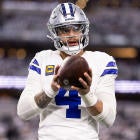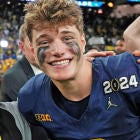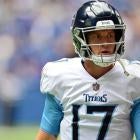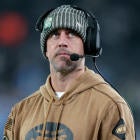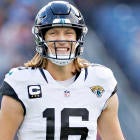The Cleveland Browns are reportedly interested in former Oregon quarterback and Heisman Trophy winner Marcus Mariota. If the Browns were to draft Mariota, it would mark the third time in four years they've selected a quarterback in the first round. They drafted Brandon Weeden at No. 22 in 2012 (using one of the picks they acquired from Atlanta in the Julio Jones deal) and Johnny Manziel (also No. 22) in 2014. Of course, Weeden is now Tony Romo's backup in Dallas, while Manziel entered rehab this off-season, so the Browns could soon be on the hunt for a quarterback of the future yet again.
Mariota is widely considered one of the top two quarterback prospects in this year's draft, along with Florida State's Jameis Winston. Most mock drafts have Mariota being selected somewhere between first and sixth (our Rob Rang, Dane Brugler and Pat Kirwan have him going sixth, sixth and first, respectively), though the majority of prognosticators have recently been moving him further down in the draft after he spent much of the season as a front-runner for the No. 1 overall selection.
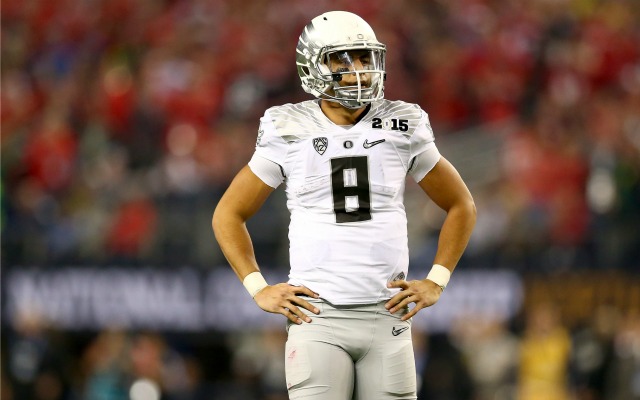
Cleveland currently owns picks 12 and 19 -- the latter was part of the haul they received from the Buffalo Bills in last year's Sammy Watkins trade -- so it's likely the Browns would have to trade up in the draft in order to secure Mariota's services. A word of advice to the Browns: don't do it.
Moving up in the draft for a quarterback rarely works out, even if the player you acquire becomes a very good one. The cost to move up in the draft is prohibitive, and because quarterback is one of the least predictable positions in terms of college success translating to the NFL, the risk is also higher than when moving up for, say, an offensive lineman.
Since 2000, 14 teams have moved up in the draft to select a quarterback in the first round. Their targets ranged in quality from Eli Manning to Brady Quinn, and the majority of the deals wound up looking bad for the team that just had to go get their quarterback of the future. Take a look at this:
| Trading up for first-round QBs | |||||||
| Draft | Trading Up | Trading Down | The Target | The Haul | AV Out | AV In | AV Diff |
| 2001 | Falcons | Chargers | Michael Vick | LaDainian Tomlinson, Tay Cody, Reche Caldwell, Tim Dwight | 68 | 176 | -108 |
| 2003 | Ravens | Patriots | Kyle Boller | Bennie Joppru, Vince Wilfork | 19 | 98 | -79 |
| 2004 | Giants | Chargers | Eli Manning | Philip Rivers, Nate Kaeding, Shawne Merriman, Roman Oben | 120 | 220 | -100 |
| 2004 | Bills | Cowboys | J.P. Losman | Julius Jones, Sean Ryan, Marcus Spears | 20 | 71 | -51 |
| 2005 | Redskins | Broncos | Jason Campbell | Karl Paymah, Brandon Marshall, Jay Cutler, Javon Walker | 36 | 86 | -50 |
| 2006 | Broncos | Rams | Jay Cutler | Tye Hill, Claude Wroten | 30 | 10 | 20 |
| 2007 | Browns | Cowboys | Brady Quinn | Anthony Spencer, Felix Jones | 3 | 65 | -62 |
| 2008 | Ravens | Texans | Joe Flacco | Duane Brown, Steve Slaton, Dominique Barber | 83 | 91 | -8 |
| 2009 | Jets | Browns | Mark Sanchez | Alex Mack, David Veikune, Coye Francies, James Davis, Kenyon Coleman, Abram Elam, Brett Ratliff | 29 | 66 | -37 |
| 2009 | Buccaneers | Browns | Josh Freeman | Alex Mack, David Veikune, Coye Francies, James Davis, Kenyon Coleman, Abram Elam, Brett Ratliff | 39 | 66 | -27 |
| 2010 | Broncos | Ravens | Tim Tebow | Sergio Kindle, Ed Dickson, Dennis Pitta | 11 | 22 | -11 |
| 2011 | Jaguars | Redskins | Blaine Gabbert | Ryan Kerrigan, Leonard Hankerson, Roy Helu, Dejon Gomes, Aldrick Robinson, Maurice Hurt | 8 | 69 | -61 |
| 2012 | Redskins | Rams | Robert Griffin III | Michael Brockers, Janoris Jenkins, Isaiah Pead, Rokevious Watkins, Alec Ogletree, Stedman Bailey, Zac Stacy, Greg Robinson | 33 | 82 | -49 |
| 2014 | Browns | Eagles | Johnny Manziel | Marcus Smith, Jaylen Watkins, Taylor Hart | 1 | 0 | 1 |
Toward the right side of the chart, you'll see some numbers that probably look a bit unfamiliar. "AV" is Pro-Football-Reference's Approximate Value, which attempts to capture in a single number the seasonal value of a player at any position from any year since 1950. It is of course inexact, but for the purposes of this exercise, it works well enough to provide us a glimpse at the "value" sent out and brought in on draft day trades for first-round quarterbacks.
"AV Out" represents the AV compiled by The Target -- the quarterback who the team that moved up in the draft acquired -- while he was with the acquiring team. So, for example, even though Jay Cutler has produced an AV of 90 in his career, he only got 30 of that with the Broncos, so that's the AV we credit them with for the trade in which they acquired Cutler.
"AV In" represents the AV compiled by The Haul -- the players the team that moved down in the draft eventually acquired. If any picks included in the initial deal were subsequently traded for other picks or players, I followed those deals to the end of the line. As with "AV Out," only AV accrued while with the acquiring team was counted. So while LaDainian Tomlinson had a career AV of 158, we're only counting the 145 he produced while with San Diego as part of the 2001 Michael Vick trade.
"AV Diff" is fairly self-explanatory: it's the difference between "AV Out" and "AV In," representing the Approximate Value gained or lost by moving up in the first round to select a quarterback. As you can see, of these 14 trades, in only two of them did the team that moved up to get their quarterback come away with a "win" according to AV.
The best of those would be Denver's 2006 trade for Jay Cutler, in which the Broncos surrendered the 15th and 68th picks in exchange for No. 11, a deal that resulted in 20 points of excess AV. The 68th pick was acquired as part of a trade the previous year, where Washington gave Denver multiple picks to move into the first round to select Jason Campbell, which didn't exactly work out that wonderfully. One of those picks turned into Brandon Marshall, another was used to trade for Javon Walker, and a third was used as part of the Cutler deal. By moving down one year and using part of that haul to move up in another, the Broncos accumulated 70 extra points of Approximate Value.
The other trade in which the team moving up in the draft for a quarterback came away with more AV than the team who moved down is Cleveland's trade in last year's draft for Johnny Manziel. The three players eventually selected by the Philadelphia Eagles produced 0 AV for them last season, while Manziel, in his disastrous rookie year, managed to produce 1 AV. Who knows what will happen to that calculation in the future, but given Manziel's performance and current personal circumstances, as well as reports the Browns are considering moving up for Mariota, it does not look great for people expecting the Manziel deal to be a win.
Similarly, though it looked quite good after the 2012 season, Washington's trade for Robert Griffin III now looks like a boondoggle. The Rams have already acquired 49 points in excess AV from the trade, and if Washington doesn't retain Griffin after his rookie contract ends, that number will only continue to grow. As the eventual fruit of the deal, the Rams wound up with three defensive starters (Michael Brockers, Janoris Jenkins, Alec Ogletree), two rotation running backs (Zac Stacy, Isaiah Pead), a solid wide receiver (Stedman Bailey) and their left tackle of the future (Greg Robinson). They still don't have their quarterback, but they have a deeper team and a far better defense than Washington, which may need to look for a quarterback once again given the friction between Griffin and head coach Jay Gruden.
Even the best player (by total AV) acquired in this fashion, Eli Manning, wound up on the losing end of the deal. The New York Giants would likely make that trade again and again if given the opportunity, considering that Manning has been a picture of health and a consistently above-average quarterback throughout his career. Even leaving aside the two Super Bowl victories, Manning has produced a lot of value for New York. Still, the haul the San Diego Chargers got in exchange for his services -- Philip Rivers, Nate Kaeding, Shawne Merriman and Roman Oben (acquired in a trade for one of the picks from the Manning deal) -- wound up producing a ton of excess value.
The best of these deals by AV was Denver's trade for Cutler, and it only resulted in a positive-20 differential. Of the other 13 trades, 10 of them resulted in a negative differential of more than 20 for the team that traded up. Even New York's deal for Manning wound up producing nearly as much excess AV for San Diego (100) as Manning has produced for the Giants in his career (120), and Manning is the best player acquired in one of these trade-ups. Quite simply, it is very, very hard to win one of these deals if you're the team that moves up for a quarterback.
Even ignoring the AV calculations, it's difficult to say that many of the teams that moved up in the draft for their quarterback "won" the deal by acquiring the best player. Taking each deal separately, it's likely that only the 2004 Giants (Manning), 2006 Broncos (Cutler) and 2008 Ravens (Joe Flacco) could confidently say they came away with the best player in the trade. And even two of those are debatable, as it's arguable that Philip Rivers has been a superior player to Manning and that Duane Brown has been better at his position (left tackle) than Flacco. The Giants and Ravens won Super Bowls with Manning and Flacco, though, so they resulted in wins for the organization, whether they got the true "best" player or not.
But nobody in their right mind would tell you that Michael Vick was better the LaDainian Tomlinson, or Kyle Boller was better than Vince Wilfork, or Blaine Gabbert was better than Ryan Kerrigan. The draft is a crap shoot, above anything else, and surrendering extra picks and/or players just gives you one less roll of the dice. Even if you think the quarterback you're moving up to acquire is a sure thing, it's more likely than not that you're wrong. Sure things don't come around very often, and tricking yourself into believing you have spotted the one guy who can change everything is more likely to come back to haunt you than to result in wild success.













